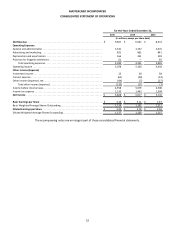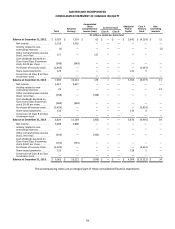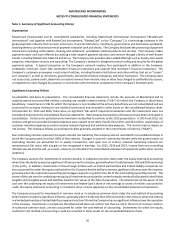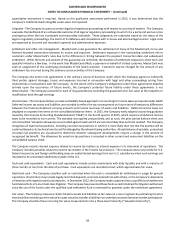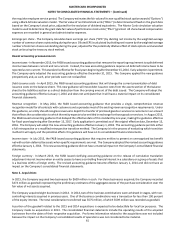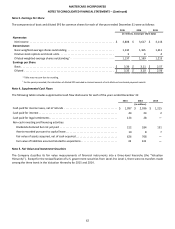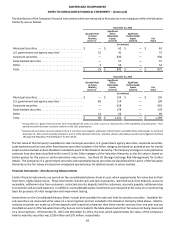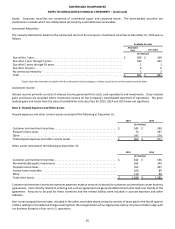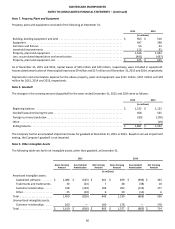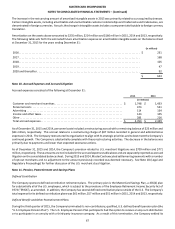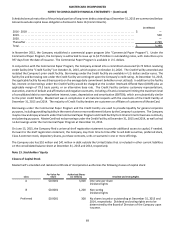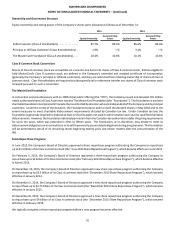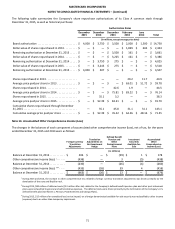MasterCard 2015 Annual Report Download - page 67
Download and view the complete annual report
Please find page 67 of the 2015 MasterCard annual report below. You can navigate through the pages in the report by either clicking on the pages listed below, or by using the keyword search tool below to find specific information within the annual report.MASTERCARD INCORPORATED
NOTES TO CONSOLIDATED FINANCIAL STATEMENTS – (Continued)
61
the requisite employee service period. The Company estimates the fair value of its non-qualified stock option awards (“Options”)
using a Black-Scholes valuation model. The fair value of restricted stock units (“RSUs”) is determined and fixed on the grant date
based on the Company’s stock price, adjusted for the exclusion of dividend equivalents. The Monte Carlo simulation valuation
model is used to determine the grant date fair value of performance stock units (“PSUs”) granted. All share-based compensation
expenses are recorded in general and administrative expenses.
Earnings per share - The Company calculates basic earnings per share (“EPS”) by dividing net income by the weighted-average
number of common shares outstanding during the year. Diluted EPS is calculated by dividing net income by the weighted-average
number of common shares outstanding during the year, adjusted for the potentially dilutive effect of stock options and unvested
stock units using the treasury stock method.
Recent accounting pronouncements
Income taxes - In November 2015, the FASB issued accounting guidance that removes the reporting requirement to split deferred
income taxes between current and non-current. Instead, the new accounting guidance requires all deferred income taxes to be
reported as non-current. This standard is effective for fiscal years beginning after December 15, 2016. Early adoption is permitted.
The Company early adopted the accounting guidance effective December 31, 2015. The Company applied the new guidance
prospectively and, as such, prior periods were not reclassified.
Debt issuance costs - In April 2015, the FASB issued accounting guidance that will change the current presentation of debt
issuance costs on the balance sheet. This new guidance will move debt issuance costs from the assets section of the balance
sheet to the liabilities section as a direct deduction from the carrying amount of the debt issued. The Company will adopt the
accounting guidance effective January 1, 2016 and does not anticipate that it will have a material impact on its consolidated
financial statements.
Revenue recognition - In May 2014, the FASB issued accounting guidance that provides a single, comprehensive revenue
recognition model for all contracts with customers and supersedes most of the existing revenue recognition requirements. Under
this guidance, an entity should recognize revenue to depict the transfer of promised goods or services to customers in an amount
that reflects the consideration to which the entity expects to be entitled in exchange for those goods or services. In August 2015,
the FASB issued accounting guidance that delayed the effective date of this standard by one year, making the guidance effective
for fiscal years beginning after December 15, 2017. Early application is permitted as of the original effective date, December 15,
2016. The Company will adopt the new accounting guidance effective January 1, 2018. The accounting guidance permits either
a full retrospective or a modified retrospective transition method. The Company is in the process of evaluating which transition
method it will apply and the potential effects this guidance will have on its consolidated financial statements.
Income taxes - In July 2013, the FASB issued accounting guidance that requires entities to present an unrecognized tax benefit
net with certain deferred tax assets when specific requirements are met. The Company adopted the revised accounting guidance
effective January 1, 2014. This new accounting guidance did not have a material impact on the Company’s consolidated financial
statements.
Foreign currency - In March 2013, the FASB issued clarifying accounting guidance on the release of cumulative translation
adjustment into net income when an entity ceases to have a controlling financial interest in a subsidiary or a group of assets that
is a business within a foreign entity. The revised accounting guidance became effective January 1, 2014 and did not have an
impact on the Company’s consolidated financial statements.
Note 2. Acquisitions
In 2015, the Company acquired two businesses for $609 million in cash. For these businesses acquired, the Company recorded
$474 million as goodwill representing the preliminary estimates of the aggregate excess of the purchase consideration over the
fair value of net assets acquired.
The Company acquired eight businesses in 2014. In 2014, two of the business combinations were achieved in stages, with non-
controlling interests acquired in previous years. One of the business combinations was a transaction for less than 100 percent
of the equity interest. The total consideration transferred was $575 million, of which $509 million was recorded as goodwill.
A portion of the goodwill related to the 2015 and 2014 acquisitions is expected to be deductible for local tax purposes. The
Company made no acquisitions in 2013. The consolidated financial statements include the operating results of the acquired
businesses from the dates of their respective acquisition. Pro forma information related to the acquisitions was not included
because the impact on the Company’s consolidated results of operations was not considered to be material.



